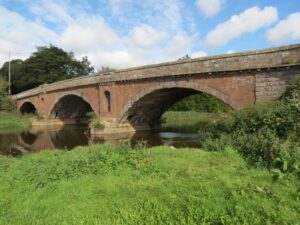Cowley Bridge – River Creedy

| Bridge Name: | Cowley Bridge | |||
| No.: | 56 | |||
| Location: | National Grid Reference:SX 90733 95502 | |||
| Build Date: | 1813-1814 | |||
| Engineer: | ames Green, Civil Engineer and Surveyor for the County of Devon | |||
|
|
||||
| Description: | Grade II listed structure: Ashlar span of 3 segmented arches; pilasters between arches with round-headed niches below parapet, and small recessed panels above. Dentilled band at road level, and coped parapet. Voussoirs are of Thorverton stone, as are the abutments to either end, and these contrast nicely with the red sandstone of the main structure. Low cutwaters. Cowley Bridge was built to replace a 12-arched bridge at the joint expense of the County of Devon and the Chamber of Exeter in the mayoralities of B W Johnson Burnes Pitch and John Flour Esquires. This information, together with the date of the laying of the first stone (22nd June 1813) is recorded on 2 inscription panels facing each other on the parapet. The bridge cost £9,000 and is Green’s most important bridge.
The monument includes Cowley Bridge, an early 19th century stone bridge spanning the River Exe some 3km upstream from the city of Exeter. It is located on the site of a succession of bridges at this spot, the earliest of which to be recorded dates to 1286. The bridge carries the road which connects Exeter with Crediton and North Devon and it is Listed Grade II*. Designed in a classical style by the civil engineer James Green, Cowley Bridge was built over the course of 1813-14 to replace an earlier bridge which was found to have been too narrow. It is constructed largely of local volcanic trap stone and comprises of three segmental arches with a total span of 50m, these arches being supported by two piers which also provide the cutwaters. There are pilasters above the cutwaters with large round-headed niches all fashioned in volcanic trap ashlar as is the dentilled exterior string-course (i.e. a line of small projecting blocks) at road level. The ashlar parapet above the string-course has coping stones of granite. The voussoirs (the visible exterior elements of the arches) are of volcanic trap ashlar as are the abutments. The total length of the bridge inclusive of its abutments is about 74m and it is 11m wide inclusive of a carriageway width of about 8m. The designer of the bridge, James Green, was born in 1781 and died in 1849; he was County Bridge Surveyor in Devon for the years 1808-1841 and Cowley Bridge is considered to be his most important work. A tablet on the southern side of the bridge records the year of construction (1813-14) and cites the work as having been carried out at the joint expense of the County of Devon and the Chamber of Exeter. A dwarf pillar on the northern side records the first stone laid on 22nd June 1813. Cowley was the site of a timber bridge known to have been in existence by 1286 and which stood until at least 1340. At some stage it was replaced by stone and major repairs are recorded in 1536 and 1545. A stone bridge at the site was destroyed by the Royalists in the Civil War around 1646 in order to frustrate a Parliamentarian advance on Exeter. The bridge which was erected in its place after the end of hostilities may have been that of four arches which was reported by Green in 1809 (only one year into his appointment as County Bridge Surveyor) to have been in good repair but too narrow. If so, it was this bridge which was replaced by Green’s three arch structure of 1813-14. |
|||
| https://historicengland.org.uk/listing/the-list/list-entry/1164147 and https://historicengland.org.uk/listing/the-list/list-entry/1021174 | ||||
| References: | ||||
